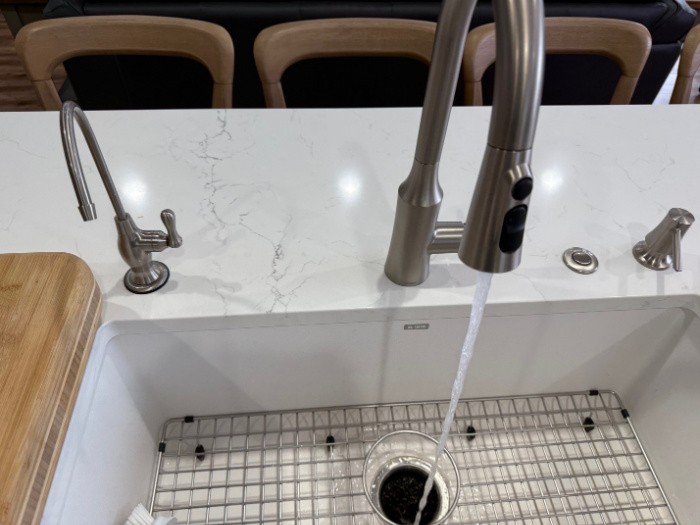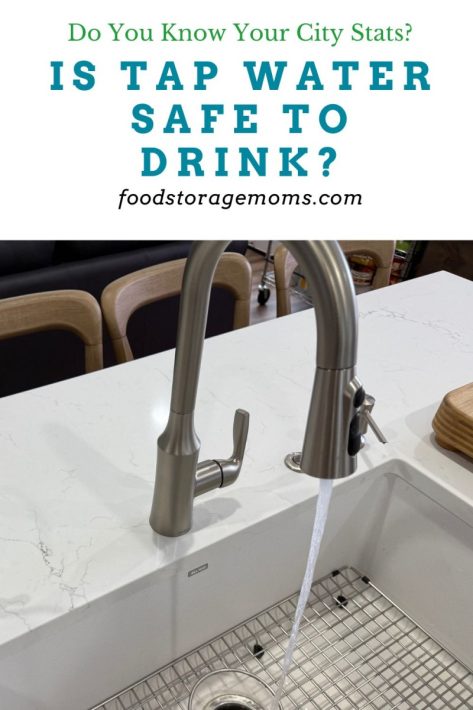
Is tap water safe to drink? The short answer to this question is yes, possibly. Tap water is generally safe to drink in most parts of the world. In the United States, tap water is closely regulated by the Environmental Protection Agency (EPA). You can put your zip code in to see your levels; they are a few years old, which is sad. But it gives you an idea of the water quality in your city.
The EPA sets standards for contaminants like lead and arsenic. The EPA has limits on how much pollutants are allowed in tap water. This is so you can feel confident that your tap water should meet their standards and be relatively safe to drink. Please note that I will NOT drink or cook with the water from my city tap. I use Reverse Osmosis.
Potential Contaminants in Tap Water
However, just because tap water meets the EPA’s regulations doesn’t mean it doesn’t contain any other contaminants or bacteria. Research has shown some chemicals are still present in trace amounts in different parts of the country.
These could be nitrates, fertilizers, and pesticides from agricultural runoff. Suppose you have a well on your property for drinking water. In that case, you’ll want to test it periodically for contamination from surface pollutants or groundwater contamination from nearby septic systems, leaking sewer lines, or landfills.

Bacterial Contamination Risk
In addition to potential chemical contaminants in your local area, bacteria can lurk in your drinking water. Bacteria can enter the system through broken pipes or improper maintenance at your local water treatment plant.
The most common types of bacteria found in tap water are coliform bacteria and E. coli. Both make you severely ill if consumed and not adequately treated. To ensure these bacteria don’t enter home systems, you must become infected and always wash your hands and clean countertops. Pay attention when using and flushing toilets; use antiseptic sprays to clean up any “spills” and flush every time used.
Most municipal water supplies are, by definition, public water systems mandated to provide safe drinking water to all those hooked up to the public water distribution system. These water supplies achieve their high water quality through sophisticated water filter systems. They are treated with chemicals that are made to kill germs, viruses, bacteria, and parasites and remove debris that may be present in the water.
What’s In Tap Water?
As you think about whether tap water is safe to drink, you may wonder what is in tap water?! Have you ever wondered what is in the water that comes from your taps? The answer, it turns out, is a bit more complicated than one might imagine. Tap water contains various minerals and chemicals, some of which are essential for our health and others that might be potentially hazardous. Let’s take a closer look into what’s really in tap water.
Essential Elements
Tap water generally contains several key minerals and elements that can benefit our health. These include calcium, magnesium, sodium, chloride, fluorine, sulfur compounds, trace amounts of iron and other elements like manganese and zinc.
Calcium is essential as it helps strengthen bones while aiding in the body’s absorption of other minerals, such as potassium. Magnesium helps with muscle performance, while sodium aids digestion and boosts electrolyte levels.
Chloride works to maintain optimal acidity levels in the bloodstream and keeps cells hydrated. Fluoride works to strengthen teeth enamel, which is why it’s so commonly added to public water supplies to help reduce tooth decay.
Sulfur compounds help neutralize any foul odor caused by unpleasant metals such as copper or zinc. Lastly, trace amounts of iron help transport oxygen throughout the bloodstream, among other things.
Contaminants
Unfortunately, there are also several compounds in tap water from human activities that can be potentially hazardous to human health if consumed excessively over long periods.
These include fluoride (in large doses), lead (often from old plumbing pipes), nitrates/nitrites (from agricultural runoff), chlorine (added for disinfection purposes), and arsenic (which can occur naturally). High levels of lead are of particular concern, and the cause of low consumer confidence reports in places like Flint, Michigan, where pediatricians found lead in the blood of sick young children.
However, these contaminants should not be cause for alarm as they usually occur in relatively small concentrations. The water is tested and compared to safe drinking standards set by governmental agencies at both local and national levels. To ensure safety, home filtration systems or specialized filters are often recommended to remove these contaminants before drinking tap water regularly and assist in disease control.
Tap water contains both beneficial minerals and specific contaminants depending on the region or town you live in. As long as you are aware of potential risks or have taken necessary precautions, there should be no reason why tap water in your sink can’t deliver safe quality drinking water supplies into your homes!
What Makes Tap Water Unsafe?
Tap water has become an indispensable part of modern life, providing us with an easy and readily available source of clean drinking water. However, despite the technological advances in water filtration systems and delivery infrastructure, tap water is still not always safe. Certain elements can contaminate it and make it potentially hazardous to drink.
Poor Infrastructure
In some parts of the world, the infrastructure for delivering safe drinking water is either inadequate or outright non-existent, so access to clean running water is a privilege rather than a right. In countries such as India, almost 70% of the groundwater from underground aquifers used for public consumption contained fluoride levels higher than acceptable health standards set by the World Health Organization (WHO). Such situations are especially worrisome due to the potential long-term health effects of continued consumption of contaminated tap water.
Do you remember the Flint, Michigan, lead issue? As mentioned above, it wasn’t until a pediatrician questioned why so many kids had lead poisoning in that city.
Every year in Utah, we hear about contaminated water in various cities. What is disturbing to me is that we often don’t hear about the “bad” water for a few days when a boil water directive is issued. Please don’t count on that water heater in your home for fresh water in case the water in your city becomes contaminated. Here is a story from The Deseret News.
There are so many instances of water quality issues it would take me hours to post them. Please keep on top of your water supply. You can use reverse osmosis for daily water purification in your home. A Big Berkey or another water purifier can be used as a stopgap until the local water system proves safe. Preventing short- and long-term health issues is a real concern; you don’t want outside sources prompting you to worry about prevention all the time.
My Personal Experience
Please note that I lived in a small town in northern Utah in 1983, and the water had a peculiar taste. The color of the water was yellow; yes, you heard that right; it was yellow. I took a white container filled with yellow water to the city and asked them why it would be yellow and unclear. They said that our water was safe and we didn’t have to worry about the water.
I didn’t believe it, and I immediately ordered water to be delivered to our home every two weeks in 5-gallon bottles. We would rotate the bottles and use them in a water dispensary unit.
A few years later, after living there, we started noticing cancer rates in our town higher than in the rest of the state at that time. Next, we gathered several neighbors and walked around the neighborhood, and to our surprise, in every third house, someone was being treated for cancer or had died from cancer. Was it from the water? We will never know.
After we moved to Southern Utah, we invested in a reverse osmosis unit, yes it removes all the minerals, but it also removes 99.99% of all the bad stuff. It costs us about $100.00 a year to replace the filter cartridges and have the unit cleaned and serviced. It was worth every penny. We have never looked back. You can get one at Costco reasonably cheap, but I am not sure about Sam’s Club.
More Tips for Storing Water
- Water Storage: How Much Do You Need?
- Creative Water Storage Solutions for Emergencies
- How To Store Water-Pros And Cons
- Bottled Water: Is It Safe to Drink?
What is the Safe Water Drinking Act of 1974?
As quoted from the website www.epa.gov: “The Safe Drinking Water Act (SDWA) was established to protect the quality of drinking water in the U.S. This law focuses on all waters actually or potentially designed for drinking use, whether from above ground or underground sources.
- The Act authorizes EPA to establish minimum standards to protect tap water and requires all owners or operators of public water systems to comply with these primary (health-related) standards.
- The 1996 amendments to SDWA require that EPA consider a detailed risk and cost assessment and best peer-reviewed science when developing these standards.
- State governments, which can be approved to implement these rules for EPA, also encourage the attainment of secondary standards (nuisance-related).
- Under the Act, EPA also establishes minimum standards for state programs to protect underground sources of drinking water from endangerment by underground injection of fluids.
Final Word
It’s clear that while tap water offers many practical benefits, certain threats are still associated with its consumption due to unforeseen contaminants or infrastructure shortcomings. The best way to ensure you are getting safe drinking water is to stay informed about your specific local situation and take necessary precautions if required.
This could mean something as simple as installing home filtration systems or purchasing bottled alternatives when necessary. Let me know in the comments below what your personal experience, both good and bad, has been with your local water system. May God Bless this World, Linda
The post Is Tap Water Safe to Drink? appeared first on Food Storage Moms.
from Food Storage Moms
No comments:
Post a Comment